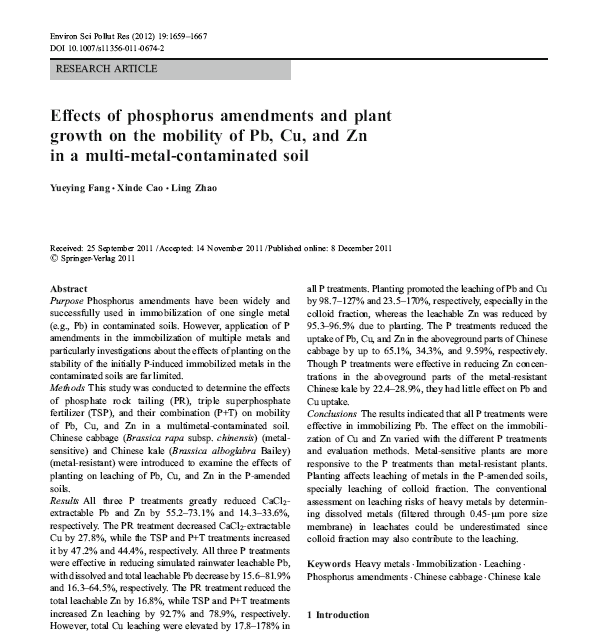Effects of phosphorus amendments and plant growth on the mobility of Pb, Cu, and Zn in a multi-metal-contaminated soil
2017-11-27
Yueying Fang & Xinde Cao & Ling Zhao
Abstract
Purpose Phosphorus amendments have been widely and successfully used in immobilization of one single metal (e.g., Pb) in contaminated soils. However, application of P amendments in the immobilization of multiple metals and particularly investigations about the effects of planting on the stability of the initially P-induced immobilized metals in the contaminated soils are far limited. Methods This study was conducted to determine the effects of phosphate rock tailing (PR), triple superphosphate fertilizer (TSP), and their combination (P+T) on mobility of Pb, Cu, and Zn in a multimetal-contaminated soil. Chinese cabbage (Brassica rapa subsp. chinensis) (metalsensitive) and Chinese kale (Brassica alboglabra Bailey) (metal-resistant) were introduced to examine the effects of planting on leaching of Pb, Cu, and Zn in the P-amended soils. Results All three P treatments greatly reduced CaCl2- extractable Pb and Zn by 55.2–73.1% and 14.3–33.6%, respectively. The PR treatment decreased CaCl2-extractable Cu by 27.8%, while the TSP and P+T treatments increased it by 47.2% and 44.4%, respectively. All three P treatments were effective in reducing simulated rainwater leachable Pb, with dissolved and total leachable Pb decrease by 15.6–81.9% and 16.3–64.5%, respectively. The PR treatment reduced the total leachable Zn by 16.8%, while TSP and P+T treatments increased Zn leaching by 92.7% and 78.9%, respectively. However, total Cu leaching were elevated by 17.8–178% in all P treatments. Planting promoted the leaching of Pb and Cu by 98.7–127% and 23.5–170%, respectively, especially in the colloid fraction, whereas the leachable Zn was reduced by 95.3–96.5% due to planting. The P treatments reduced the uptake of Pb, Cu, and Zn in the aboveground parts of Chinese cabbage by up to 65.1%, 34.3%, and 9.59%, respectively. Though P treatments were effective in reducing Zn concentrations in the aboveground parts of the metal-resistant Chinese kale by 22.4–28.9%, they had little effect on Pb and Cu uptake. Conclusions The results indicated that all P treatments were effective in immobilizing Pb. The effect on the immobilization of Cu and Zn varied with the different P treatments and evaluation methods. Metal-sensitive plants are more responsive to the P treatments than metal-resistant plants. Planting affects leaching of metals in the P-amended soils, specially leaching of colloid fraction. The conventional assessment on leaching risks of heavy metals by determining dissolved metals (filtered through 0.45-μm pore size membrane) in leachates could be underestimated since colloid fraction may also contribute to the leaching.
